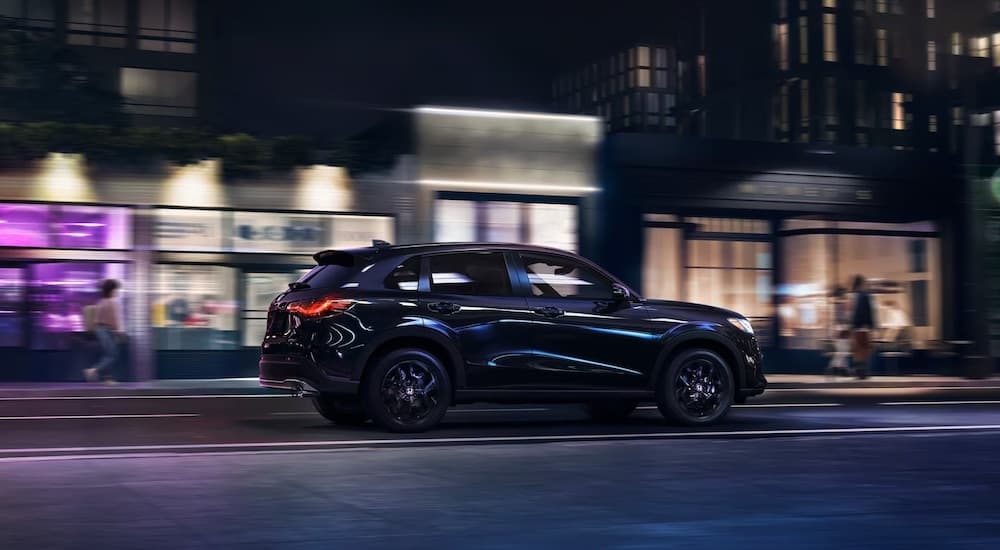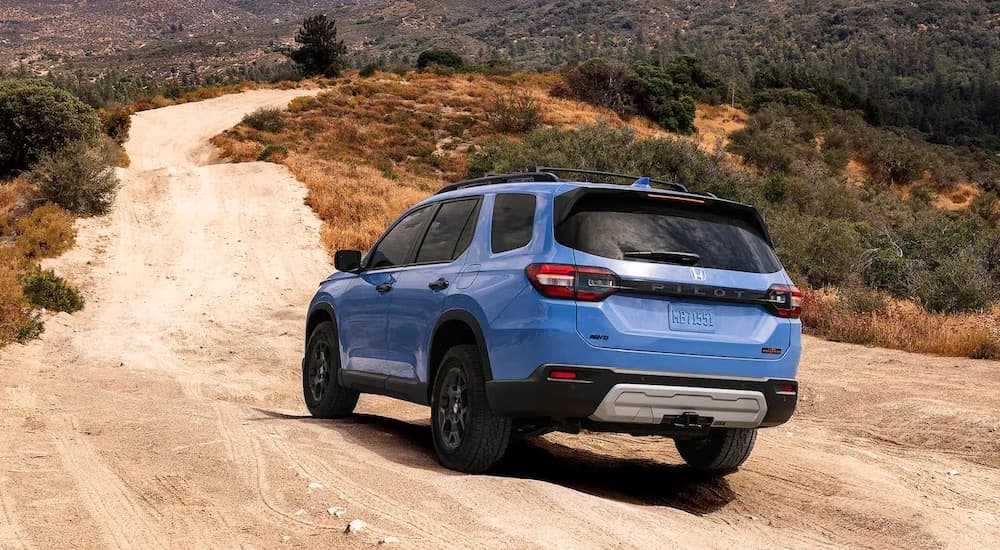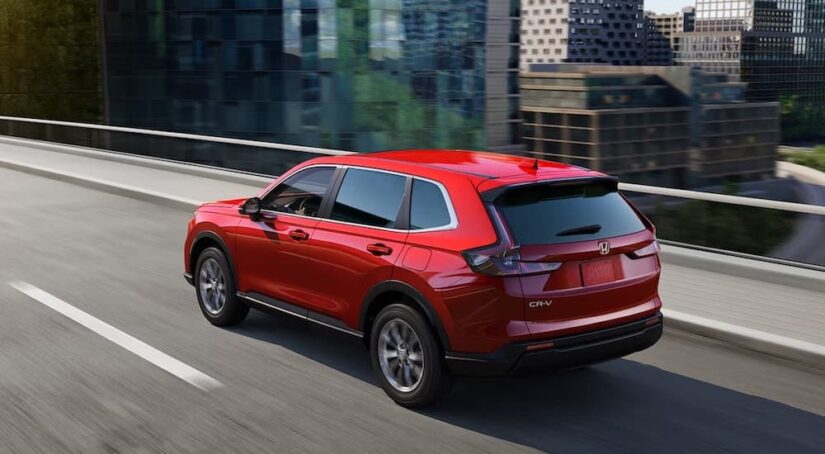Shopping for SUVs for sale is no easy feat because there are dozens of options from the world’s leading automakers, each promising to have the best model for your needs. Truthfully, not all SUVs are equal. Some are more reliable, more engaging to drive, more efficient, and better-equipped than others. So, how do you choose? Turning to a reputable brand like Honda is an excellent start.
Honda has an outstanding reputation for building long-lasting vehicles with tangible value. The automaker helped establish the crossover segment with the CR-V in the late 1990s and has since proven its ingenuity with models like the HR-V, Pilot, Passport, and Prologue. These SUVs showcase Honda’s willingness to go the extra mile to build SUVs that answer every need without asking drivers to compromise.
Even so, shopping Honda’s lineup can be confusing. You need more than an overview of your options. Instead, you want the basic questions about each SUV answered, like which models have three rows or all-wheel drive and which are the most efficient. Here’s a closer look at those questions and the answers, based on Honda’s 2024 SUV lineup, to kickstart your search for the best SUV for your unique driving needs.
#1 – Let’s Talk Fuel Economy: Which Honda SUV is the Most Efficient?
When looking at fuel economy in Honda’s 2024 SUV lineup, you have to consider whether the model is all-electric, a hybrid, or powered solely by a gas engine. For example, the 2024 Prologue is Honda’s all-electric SUV that offers a driving range of up to 296 miles on the front-wheel drive model. Consider how far you travel daily relative to the Prologue’s estimated driving range to determine how well its range can meet your needs.
Honda’s hybrid SUVs are more efficient because they rely on an electric motor and a gas engine to manage the demands of driving. We see the difference by comparing the most fuel-efficient SUVs in the Honda lineup—the CR-V Hybrid and the CR-V. The CR-V Hybrid has a combined fuel economy of 40 MPG, averaging 43 MPG in the city and 36 MPG on the highway with front-wheel drive. The non-hybrid option is still the most efficient in Honda’s gas-powered lineup, averaging 28 MPG in the city and 34 MPG on the highway with front-wheel drive.

#2 – Let’s Talk Transmissions: Which Honda SUVs Have an Automatic Transmission? Which Have a CVT?
Drivers tend to have transmission preferences, with some arguing the advantages of an automatic transmission and others enjoying the heightened efficiency of a continuously variable transmission. Fortunately, Honda offers both in its SUV lineup. The subcompact HR-V and compact CR-V are outfitted with 2.0L and 1.5L engines, respectively, and a continuously variable transmission that prioritizes efficiency is equipped in both models. Alternatively, larger models like the midsize Passport and three-row Pilot have a nine-speed and ten-speed automatic transmission to accommodate their larger engines.
#3 – Let’s Talk All-Season Confidence: Which Models Offer All-Wheel Drive?
Front-wheel drive is common across the SUV segment, with most base models rolling off the factory floor with this standard drivetrain. As a result, all-wheel drive is often considered an upgrade designed for those who spend more time navigating slippery conditions. Yet, more and more drivers are discovering the value of an intelligent all-wheel drive system that constantly monitors the wheels to optimize traction and their control in the driver’s seat. The inclusion of this type of drivetrain gives the Honda lineup another distinct advantage.
Honda SUVs like the CR-V, Prologue, HR-V, and Pilot are offered as front-wheel drive models, with the option to upgrade to all-wheel drive. The Passport is the only model that rolls off Honda’s production line with all-wheel drive, making the midsize SUV a standout in the segment. Unsurprisingly, its all-wheel drive performance doesn’t dramatically impact its efficiency, with the midsize road warrior offering a combined fuel economy of 21 MPG.
#4 – Let’s Talk Size and Capacities: Which Honda SUVs Have Three Rows and the Most Cargo Capacity?
Honda does an outstanding job designing functional and versatile SUVs without compromising comfort or the vehicle’s overall style. The Honda lineup is stacked with two-row options that include the HR-V, CR-V, Passport, and Prologue, leaving the Pilot as the only three-row option. As a subcompact SUV, the HR-V is the smallest in the fleet, succeeded by the compact CR-V and the midsize Passport and Prologue.
How do the models compare in terms of cargo capacities? It’s easy to assume that the subcompact HR-V would have significantly less cargo room than the midsize Prologue; however, that isn’t the case. The 2024 HR-V has 24.4 cu.ft. of space behind the second row and 55.1 cu.ft. behind the second row. Alternatively, the Prologue prioritizes passenger comfort by offering more head and legroom across both rows, which reduces the SUV’s cargo capacity to 57.7 cu.ft. with the second row folded or 25.2 cu.ft. with the second row upright.
As a three-row SUV, the Pilot is the most spacious and offers a total cargo capacity of 111.8 cubic feet with the second and third rows folded. From there, the midsize Passport outshines the compact CR-V by providing 100.7 cu.ft. of space. In contrast, the CR-V boasts a total cargo capacity of 76.5 cu.ft., which is still spacious for an SUV of its size. However, it’s also essential to consider that the Pilot and Passport can support even more gear with their 5,000-pound towing capacities.

#5 – Let’s Talk Hybrid Options: Which Honda SUVs Are Available as Hybrids?
Like many automakers, Honda is keen to build a greener, more sustainable future. This is apparent in Honda’s SUV lineup, which includes a hybrid and an all-electric option. The best-selling CR-V is available with a 2.0L hybrid powertrain that produces 204 hp and 247 lb-ft of near-instant torque to make the compact SUV agile and engaging to drive. Alternatively, the midsize Prologue is Honda’s all-electric road warrior that offers a single or dual-motor powertrain that delivers anywhere from 212 to 288 hp and 236 lb-ft to 333 lb-ft of instant torque.
#6 – Let’s Talk Tech: Which Honda SUV Has the Biggest Infotainment Display?
Technology is at the heart of everything we do, so it only makes sense to wonder how Honda outfits its SUVs with the latest features to keep us connected and informed. Fortunately, Honda’s SUV lineup is tech-focused and boasts the latest safety, driver-assist, and connectivity apps to enhance your experience behind the wheel. These technologies stretch from the Honda Sensing Suite of safety and driver-assist tools to seamless smartphone integration via Apple CarPlay and Android Auto. So, how do the models differ? It all comes back to display size.
The HR-V, CR-V, and Pilot feature a standard 7-inch display with Honda’s intuitive infotainment system, connectivity tools, and rearview camera. Top-tier trims gain the upgraded 9-inch display, and Honda also includes navigation with certain models. The Prologue sits at the top of the ranks with its expansive 11.3-inch touchscreen, truly showcasing the future of technology in the Honda lineup.
#7 – Let’s Talk Pricing: What Can You Expect to Pay?
Honda’s reputation for reliability makes its SUV lineup incredibly appealing, but the automaker doesn’t force drivers to pay a premium for a high-quality SUV. Instead, Honda offers tangible value across its lineup in the form of sophisticated designs, well-equipped cabins, advanced driver-assist tools, seamless connectivity, and engaging powertrains. As a result, your money is seemingly well-spent in a Honda SUV, whether you opt for the most affordable HR-V at $24,600 or splurge for the all-electric Prologue, which starts at $47,400.



